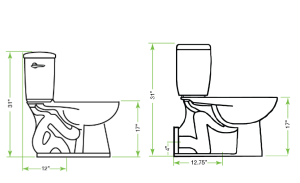Whether you own or manage a facility, choosing the types of fixtures that are installed or replacing older fixtures can be a difficult process. Between understanding upfront costs as well as ongoing maintenance and bills that come from powering them, choosing things like faucets and lights can be frustrating, but not as much as choosing toilets. With endless options in style, functionality, and installation it’s enough to make someone’s head spin. These five tips will help you narrow down the best investment you can make for a toilet at your facility.
1. Choose the Right Flush Technology
Before 1980, people depended on the volume of water a toilet uses to provide enough force to push waste through the toilet and down the drainpipe. Over the last fifty years, government regulations and climate changes have pushed the plumbing industry to go from using 7.0 GPF to a standard of 1.6 GPF. There are now three options to consider when looking at flush technology: gravity-fed, pressure-assist, and vacuum assist.
Most are familiar with the gravity-fed technology that uses a flapper. Gravity-fed toilets are used mainly in homes and residential spaces, but some have been seen in the odd gas station or single bathroom office spaces. For someone who is running a large commercial facility, gravity-fed toilets are not ideal. A commercial facility with a high level of traffic will prefer a pressure-assist toilet. Pressure-assist toilets use highly pressurized air to empty the bowl and push waste through the drainpipe. Pressure-assist toilets come in both floor and wall-mounted options and can be paired with a tank or a flushometer – a metal water-diverter that uses an inline handle. Both options can be found with flush volumes as low as 1.0 GPF (well below the national standard of 1.6 GPF) and are perfect for facilities that are older or see high amounts of traffic. The force of the pressure-assist flush will push media down older drain lines that may tend to clog, cutting back on ongoing maintenance and additional costs.
Somewhere in the middle with a multi-family property? Because pressure-assist toilets are louder than other toilet technology types due to the forced air used to evacuate the bowl, they are rarely found in residential or other low-traffic applications. Vacuum-assisted technology is the best of both worlds by providing a powerful, but quiet flush. The powerful, quiet flush paired with efficient water use is typically the main reason multi-family facilities choose a toilet with vacuum-assist technology. With no change in the way it’s used, the toilet supplies a powerful flush while reducing the amount of water used, creating remarkable cost savings through the life of the toilet.
2. Make Sure the Toilet is Efficient
According to the EPA, restroom fixtures in buildings account for more than a third (37 percent) of total water usage in an average building. In addition, large buildings use 22,000 gallons per building per day according to the EIA. Toilets typically account for 60% of the total use of water at commercial facilities. The EPA estimates that water-conserving toilets can reduce water usage, lowering monthly water costs significantly and saving more than 13,000 gallons of water annually.
By using only toilets with the WaterSense® and MaP® certifications, you’re guaranteed to save money, water, and time. These toilets are certified to be high-performing but use less water than the national mandate, so you will save money through a lower water bill and not so many maintenance calls.
3. Ensure the Toilet is Durable
If you’re purchasing for a commercial space, the toilet you choose will need to be durable. Lots of people using the various parts that make a toilet function are one factor, but if you’re worried about longevity, consider a toilet with a lower flow. Less water = less corrosion, use, and maintenance needs.
4. Does the Toilet Fit the Space?
Whether you’re purchasing toilets for a commercial, residential, or multi-family property, space is always a concern. Start by weighing your options between a wall mount or a floor mount option. If you’re trying to save space, a wall-mounted toilet is a good option. It’s smaller and easier to clean, but it’s usually much more expensive than floor-mounted options and can be tough to make repairs because the actual mechanics of the toilet are embedded in the wall and not immediately accessible. Floor-mounted toilets may be a little harder to clean, but they’re faster to install, the tanks usually come pre-assembled, and they’re much easier to repair.
There are also options for the bowl shape: elongated, round, or compacted elongated. An elongated bowl shape is ideal for comfort, whereas a round toilet is the best option if you’re short on space. A compact elongated bowl is an option that bridges the gap between elongated and round. While offering comfort, it still saves on space.
5. Check the Toilet Install Procedure
You will also want to look at the type of rough-in and how large the footprint is. The term “rough-in” refers to how the toilet hooks up to the plumbing system. Toilets typically have a 12″ rough-in that either connects to the plumbing system through the wall or the floor.
The footprint of a toilet is determined by the size of the bowl and the area the bottom of the toilet takes up. If you’re replacing a floor-mounted toilet but you’re not replacing the flooring, you will want to find a toilet that has a larger footprint so that there are no gaps in the flooring.
As a parting gift here is a bonus tip: be sure that you check your fixture’s warranties. A toilet has an average life span of 10-15 years. Most toilets have warranties of at least a year, but like most warranties, they come with restrictions. Be sure that you find a toilet with a warranty of at least 5 years and that they cover most, if not all of the functional pieces of the toilet.

